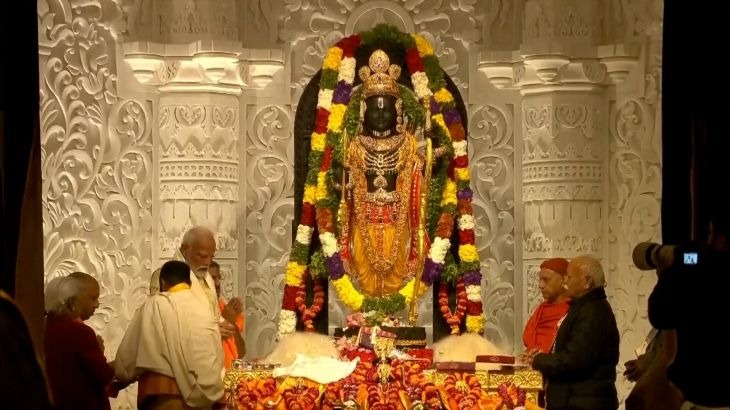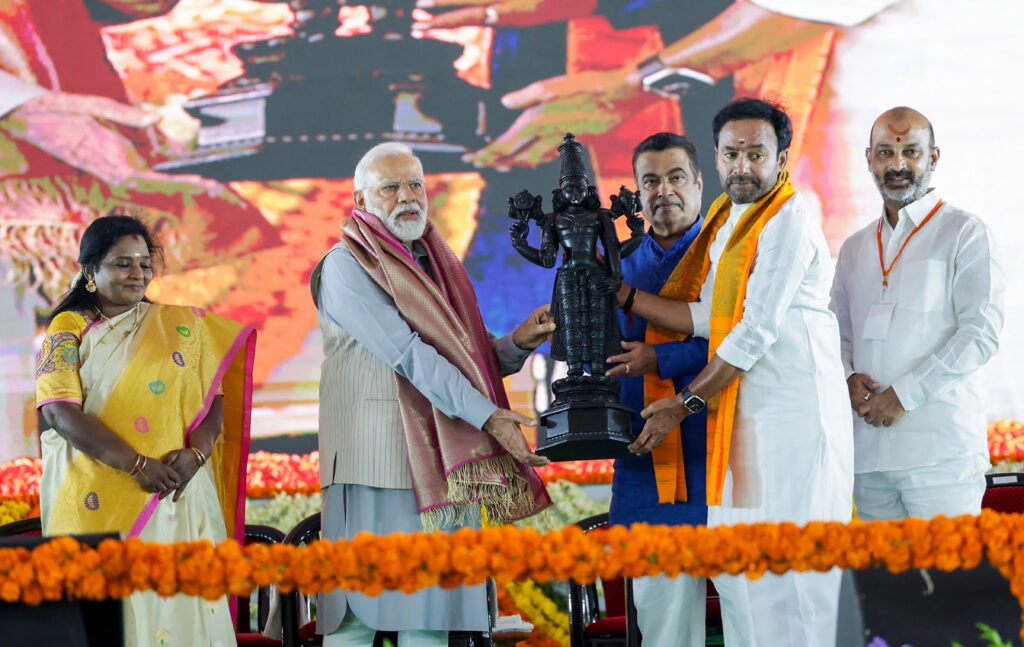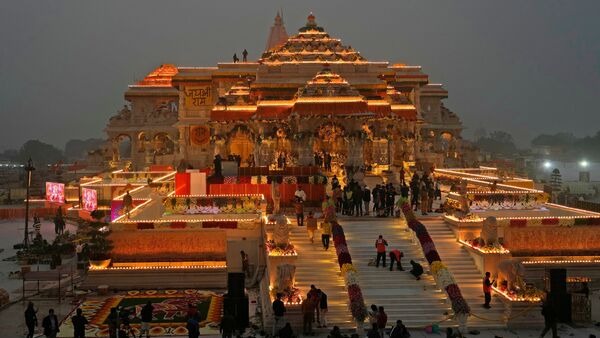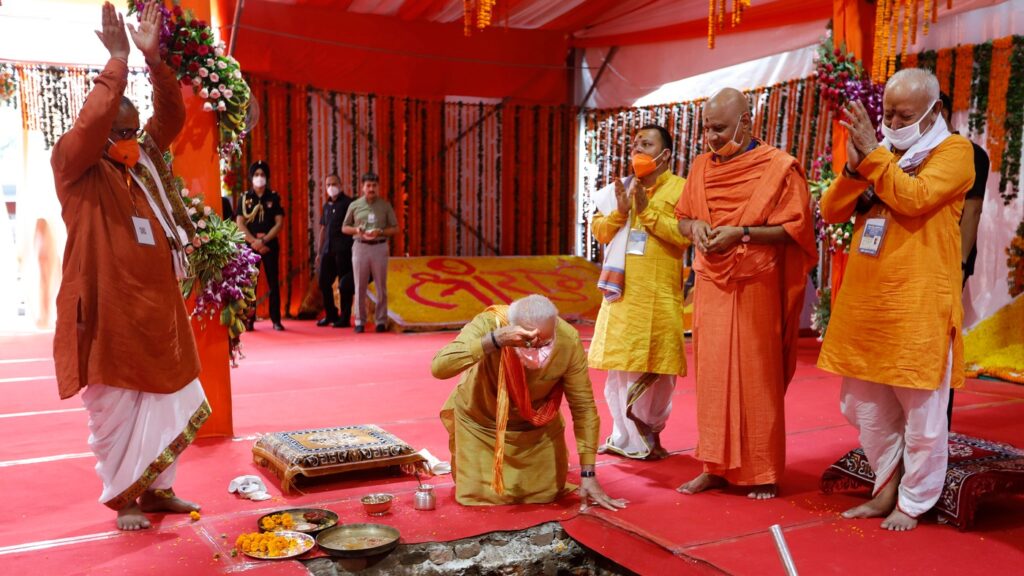Modi unveils Hindu temple on mosque’s site

Narendra Modi praises contentious inauguration as the realization of a dream that many have cherished for years.
Over thirty years following the destruction of a mosque by a mob of militant Hindu radicals in the town of Ayodhya, Indian Prime Minister Narendra Modi has now inaugurated the new Hindu temple erected at the site.
For many, this inauguration symbolizes a profoundly significant religious event. Numerous Hindus consider Ayodhya to be the birthplace of the revered deity Lord Ram. The construction of the temple, after more than a century of disputes, is viewed as Lord Ram returning to his rightful place and India liberating itself from the burdens of past religious conflicts.
Modi personally referred to it as the realization of “the dream that many have cherished for years.” During the Prana Pratishtha, the rituals on Monday to consecrate the temple and bestow offerings and blessings upon the idol of the young Lord Ram placed in the inner sanctum, Modi assumed a prominent role. He had dedicated the past 11 days to observing a special purification ritual in preparation for this momentous occasion.

The consecration of the Ram temple evolved into a nationwide event, hosting 8,000 official guests, encompassing politicians, diplomats, Bollywood celebrities, and religious leaders. Simultaneously, hundreds of thousands of pilgrims journeyed to Ayodhya from various parts of the country to express their devotion to the new temple and Lord Ram. The town underwent a government-funded transformation amounting to $3 billion, adorned with flowers, saffron flags, depictions of Ram, and billboards featuring Modi.
Arjun Kumar, a 22-year-old driver, embarked on a pilgrimage, covering the 466 miles (750 km) from Delhi to Ayodhya over the past 20 days. Reflecting on this significant journey, he remarked, “I consider it as the most important journey of my life. Many of my friends were afraid to take this journey, but we are followers of Lord Ram and Narendra Modi; no one can stop us. I believe every Hindu should undertake this walk to convey the message that this country belongs to us, and no one can impede us.”
Following the ceremony, devotees gathered near the Ram Mandir. Bharat Patel, a 52-year-old herbal medicine seller from Gujarat, expressed, “On reaching here and looking at the temple, I collapsed and cried. I can say we felt heaven here. This is a proud moment for Hindus worldwide.”
Some opted to boycott the ceremony, accusing Modi of orchestrating the event for political advantage ahead of the upcoming elections in the spring, where he aims for a third term in power.
The demolition of the mosque in 1992 paved the way for Hindu nationalism to become the prevailing political force it is today. The commitment to constructing a Ram Temple in Ayodhya has been a central element of Modi’s Bharatiya Janata Party’s (BJP) political agenda, emphasizing the establishment of Hindu supremacy in India.
Although the temple’s completion is scheduled for next year, a few Hindu holy figures objected to its early inauguration. Besides Modi, the participants in Monday’s temple consecration ceremony included Yogi Adityanath, the hardline Hindu monk and BJP chief minister of Uttar Pradesh, and Mohan Bagwat, the head of the Rashtriya Swayamsevak Sangh, the right-wing Hindu paramilitary organization that gave rise to the BJP.

Kapil Komireddi, the author of Malevolent Republic: A Short History of New India, emphasized the close alignment between the prime minister and the Ram temple as indicative of the threat posed by the BJP to India as a secular republic, where the constitution upholds the equality of all religions.
This is a purely political spectacle, the culmination of a 40-year political project – one that has been achieved through great violence,” said Komireddi. “It is the coronation of Hinduism as India’s state religion and the crowning moment for the cult of personality erected around Modi. I see this as a very sad moment for India.
Controversies regarding the sacred site in Ayodhya have a history spanning over a century. The Babri Masjid, constructed in 1528 by the Mughal emperor Babur, a Muslim leader in India for almost 500 years, stood at the location. However, Hindus subsequently asserted their claim to worship at what they believed to be the birthplace of Lord Ram.
Muslims continued their worship at Babri Masjid until 1949, when a small hardline Hindu group took up the issue. They claimed that a temple had previously existed at the site and vowed to “liberate” the land, intending to reconstruct it. Following the alleged placement of a Ram idol in the mosque, reportedly by a Hindu priest, its gates were locked.
The campaign by right-wing Hindu groups to reclaim Ayodhya and construct a temple regained momentum in the 1980s. By 1990, leaders of the BJP, an emerging political party at the time, threw their support behind the movement, organizing marches to Ayodhya.
In December 1992, a mob marched into Ayodhya, utilizing sledgehammers, axes, and iron rods to dismantle the mosque within hours. Several senior BJP figures were reportedly present during this event.
In November 2019, the Supreme Court deemed the demolition illegal but granted the land title to the Hindu side. No convictions have been secured for the demolition or the subsequent violence in Ayodhya. The unrest claimed the lives of 17 Muslims in the town and triggered riots nationwide, resulting in the death of over 2,000 people.
For Shri Mahant Dharamdas Akhil, a 75-year-old Hindu priest and a disciple of the priest who allegedly placed the Ram idol in the mosque in 1949, Monday’s temple inauguration marked the culmination of a cause he had devoted his life to, describing it as “one of the most important days in India’s history.” Akhil, who participated in the Babri Masjid demolition in 1992 and was also a petitioner in the Supreme Court case, viewed it as a “just cause,” attributing the structure’s fall to divine intervention. He emphasized that the Ram temple would now become a crucial place in Hinduism worldwide.
However, for the Muslims of Ayodhya, Monday’s ceremony stirred old trauma and fear, particularly for those who lost relatives or had their homes destroyed in the 1992 violence surrounding the mosque’s demolition. Abdul Wahid Qureshi, a 44-year-old shopkeeper, recalled the events of 1992 when a right-wing Hindu mob rampaged through his locality, resulting in the death of Muslims. Qureshi survived because a nearby Hindu offered them shelter. Reflecting on the grim scenes, he stated, “I can never forget those gory scenes. That day changed everything for us as Muslims in Ayodhya. We returned after a couple of weeks, and my father managed to build a new house. But since then, the sense of security is gone.

Qureshi expressed concern that many Muslims were apprehensive about the influx of hundreds of thousands of outsiders into Ayodhya, fearing they might once again become targets. During the temple festivities, half of the Muslim households were deserted. Qureshi said, “All this takes me back to 1992. I am afraid, like all other Muslims here, what will happen to us after the dignitaries are gone and security is lifted.”
Anwari Begum, whose husband was dismembered and killed by the mob in 1992, revealed that she had never received justice for his death. However, she expressed acceptance of the situation for the greater good, stating, “But I have made peace with it in the larger good. If the construction of the temple will bring peace here, I will stop asking for justice in the killing of my husband.


